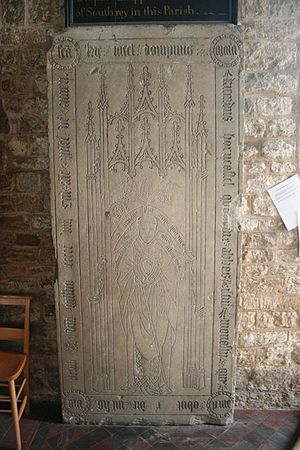Bardney Abbey facts for kids
Bardney Abbey was a special religious building in Lincolnshire, England. It was a Benedictine monastery, which is a place where monks live and pray. King Æthelred of Mercia started it in the year 697. He even became the first abbot, who is the leader of a monastery.
Sadly, the monastery was probably destroyed in 869 during a raid by Vikings from Denmark. But it was rebuilt! In 1087, it became a smaller religious house called a priory. This was thanks to Gilbert de Gant, Earl of Lincoln. By 1115, it was big and important enough to become an abbey again.
In 1537, a sad event happened. Six monks from Bardney Abbey were executed. This was because they were involved in something called the Lincolnshire Rising. This was a protest against King Henry VIII. The very next year, in 1538, the Abbey was closed down. This was part of a big event called the Dissolution of the Monasteries. King Henry VIII took all the Abbey's land and buildings. Sir Robert Tirwhit was given the property.
Sir Robert Tirwhit kept the abbot's house for himself. He turned the cloister, which was an open courtyard in the monastery, into a garden. Over time, these buildings also became ruins, just like the rest of the Abbey.
Today, you can still see the old layout of Bardney Abbey. This was discovered during excavations, which are like archaeological digs, from 1909 to 1914. More work was done in 2009 and 2011. Some old grave stones and carved pieces are kept safe in the local church in Bardney. The site is now looked after by a charity called the Jews' Court and Bardney Abbey Trust.
Contents
Famous Burials at Bardney Abbey
Bardney Abbey was an important place where several famous people were buried. These included kings, queens, and important nobles.
King Oswald of Northumbria
One of the most famous people buried here was Oswald of Northumbria. He was a king who lived a very long time ago. People believed he was a saint.
Other Important People
Many other important figures were laid to rest at Bardney Abbey. These included:
- Æthelred of Mercia: The king who founded the Abbey.
- Osthryth: A queen from a long time ago.
- Gilbert de Gant: The person who helped rebuild the Abbey.
- Alice de Montfort-sur-Risle: Gilbert de Gant's wife.
- Walter de Gant: Gilbert de Gant's father.
- Maud of Brittany: Walter de Gaunt's wife.
- Alice de Gant: Walter de Gant's daughter.
Images for kids







